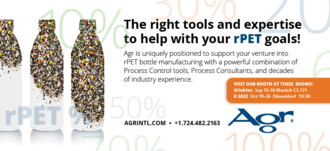For the first time, a dairy company is launching a PET bottle for UHT milk using Sidel’s Predis™ dry decontamination technology. The technology has allowed LSDH (France) to reduce the weight of its bottles by 20 percent as well as making drastic savings in chemicals and waters. Operations just started in summer 2009.
| Packaging milk poses its own challenges since the product is easily destroyed by light, microbes and air. Dry decontaminated PET bottles have now proven an ideal packaging solution for the French dairy company LSDH to combat these problems in an eco-friendly way. |
Aseptic decontamination: the dry choice
The key element of the new line, the Combi Predis™ FMa, is a compact machine for blow-molding bottles, filling and capping them, specifically for sensitive products under aseptic conditions.
The vital difference between this system and traditional processes is that Sidel’s new technology works by decontaminating not the bottles, but the preforms. Hydrogen peroxide (H2O2) vapor is evenly sprayed on the interior surfaces of the preforms and then activated by the heat used in the blow-molding process. This thorough decontamination makes it possible to increase product quality and shelf life and to ensure total food safety until the expiry date. The process uses only a small amount of chemicals and virtually no water. Additional benefits of the Combi Predis™ FMa are fast output rates and the system’s flexibility. The latter is particularly important when products have to be changed frequently. LSDH carries out product changes three or four times a week on the same line, which runs 24 hours a day, six days a week, in order to bottle short runs and promotional products.
Environmental benefits are key
It was mainly environmental considerations that swayed LSDH’s decision in favour of the Predis™ system. Emmanuel Vasseneix, CEO at LSDH, explained: “You have to look ahead to the company’s future responsibilities, both to society and to the environment. The dry decontamination system consumes very little disinfectant and it reduces water consumption to next to nothing. It also allowed us to reduce the bottle weight from 28 to 24 grams.”
Traditionally LSDH had used opaque HDPE and, later, paperboard on Tetra Pak lines for packing its milk. The company started PET packaging for milk in 2007 after it diversified into fruit juices earlier. Dry decontamination was introduced in the latest move.
Emmanuel Vasseneix explained the advantages that PET has over other packaging materials for bottling milk: “PET offers better protection from odors than HDPE. It also allowed us initially to produce a bottle lighter than 30 grams, which is the weight of the traditional 1-liter HDPE bottle. Since we have been able to replace the traditional aluminium seal with a water-tight lid, we are contributing to waste elimination. Using PET therefore helps us to meet our company’s eco-design requirements.”
In the future LSDH is looking to lighten its PET milk bottle down to 22 grams. Since PET also allows diversifying and personalizing bottle shapes, the future is likely to bring more milk bottle innovations through LSDH’s collaboration with Sidel.
Sidel has got a globally installed base of more than 120 aseptic filling machines and roughly 40 dry decontamination systems.
| Sylvie RAK Tel : +33 2 32 85 82 46 sylvie.rak@sidel.com |








